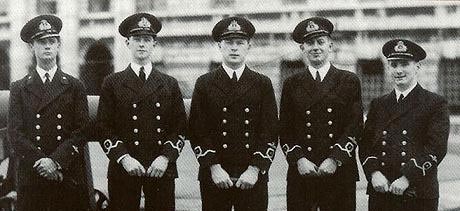
(From left) Eric Margetts, Bobby Lawson, John Moffat, Buster May and Glan Evans
On May 27, 1941, the German battleship Bismarck had just sunk the pride of the Royal Navy, HMS Hood. As she was close to escaping into safe waters, Bismarck was attacked by a swarm of obsolete Fairey Swordfish biplanes launched from the carrier HMS Ark Royal. Lt-Cdr John “Jock” Moffat, one of the Swordfish pilots, died recently at the age of 97. Lt Cdr Moffat was credited with launching the torpedo that crippled the Bismarck in 1941.
As reported by the BBC: Mr Moffat and his crew took off in his Swordfish L9726 from the deck of Ark Royal and headed for the Bismarck, fighting against driving rain, low cloud and a gale.
Naval chiefs said he flew in at 50ft, nearly skimming the surface of the waves, in a hail of bullets and shells, to get the best possible angle of attack on the ship. At 21:05 he dropped the torpedo which hit its target, jamming the rudder of Hitler’s flagship. Speaking to BBC Scotland earlier this year, he said: “The Bismarck turned on its side and all these sailors seemed to be in the water – it lived with me for a long time.” The battleship was forced to steam in circles until the guns of the Royal Navy’s home fleet arrived the next morning.
“When Churchill gave the order to sink the Bismarck, we knew we just had to stop her trail of devastation at all costs,” he said. “The great thing about the Swordfish was that the bullets just went straight through. After all, it was only made of canvas. It was like David and Goliath.”
Born in Kelso in June 1919, he joined the Navy as a reservist in 1938 and was posted to Ark Royal with 759 Naval Air Squadron after qualifying as a pilot.
After the war he trained as a hotel manager and remained with the profession for decades. He took up flying again in his 60s and flew into his early 90s.
In recent years he campaigned for the No side in the Scottish independence referendum, appearing alongside Scottish Conservative leader Ruth Davidson in 2014 to make the defence case for the Union.
Mr Moffat’s death was announced by the Royal Navy.

You’ll notice that the four on the right are all lieutenants, and that the braid on their sleeves is wiggly, denoting that they were all Royal Navy Voluntary Reserve — RNVR. Because of the wiggly braid, they were known as the “Wavy Navy.” The song they sang was: “We signed up for the fun, and the money. Of the money we have none, but the fun has just begun, roll along, Wavy Navy, roll along.”
Very interesting. Thanks, Seymour.
Mr. Eric Margetts on the left was a Midshipman RNVR. I suspect the braid on Mr. Glan Evans is “half-braid” size making him a Warrant Officer RNVR, Rick says rather interesting. All have their wings above their Rank insignia.
Good Watch.
The RNVR existed from 1916 – 1958 and the Ranks (there are no Rates) can be found at:
http://www.uniforminsignia.org scroll down to United Kingdom and then click on SEARCH
Good Watch.
We absolutely love your blog and find nearly all
of your post’s to be just what I’m looking for. Do you offer
guest writers to write content for you? I wouldn’t mind composing a post or elaborating on most of the subjects you write with regards to here.
Again, awesome website!